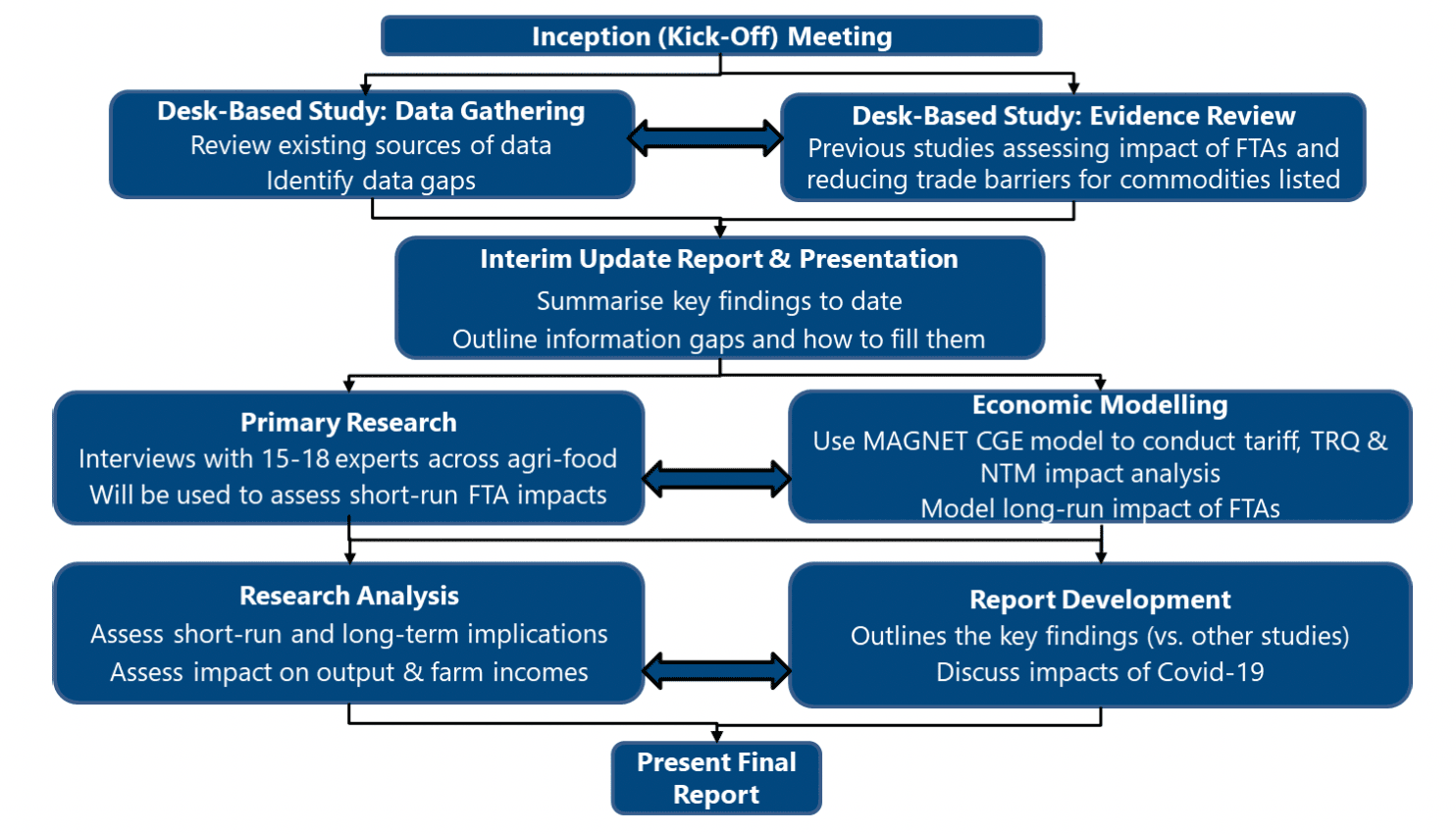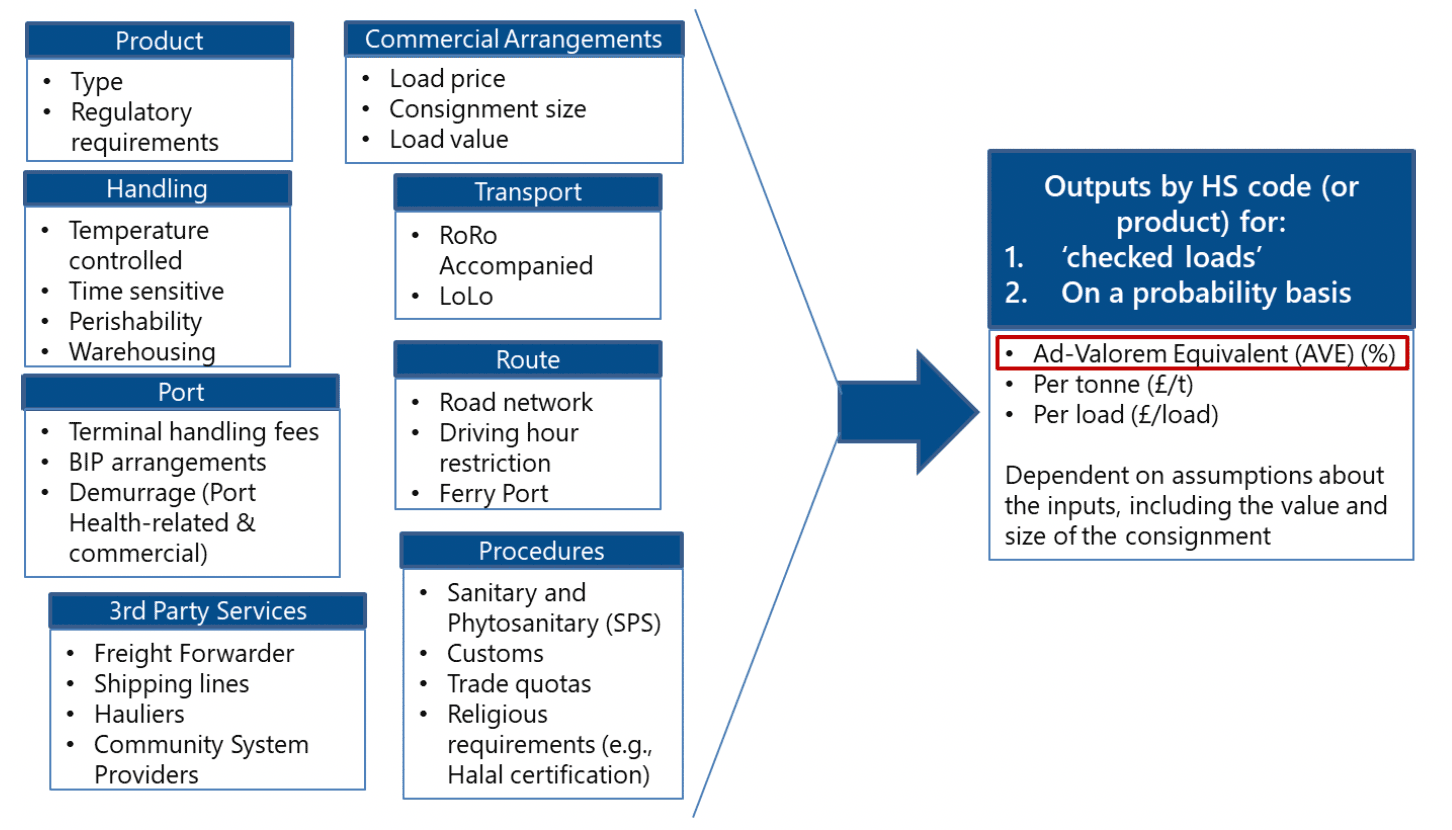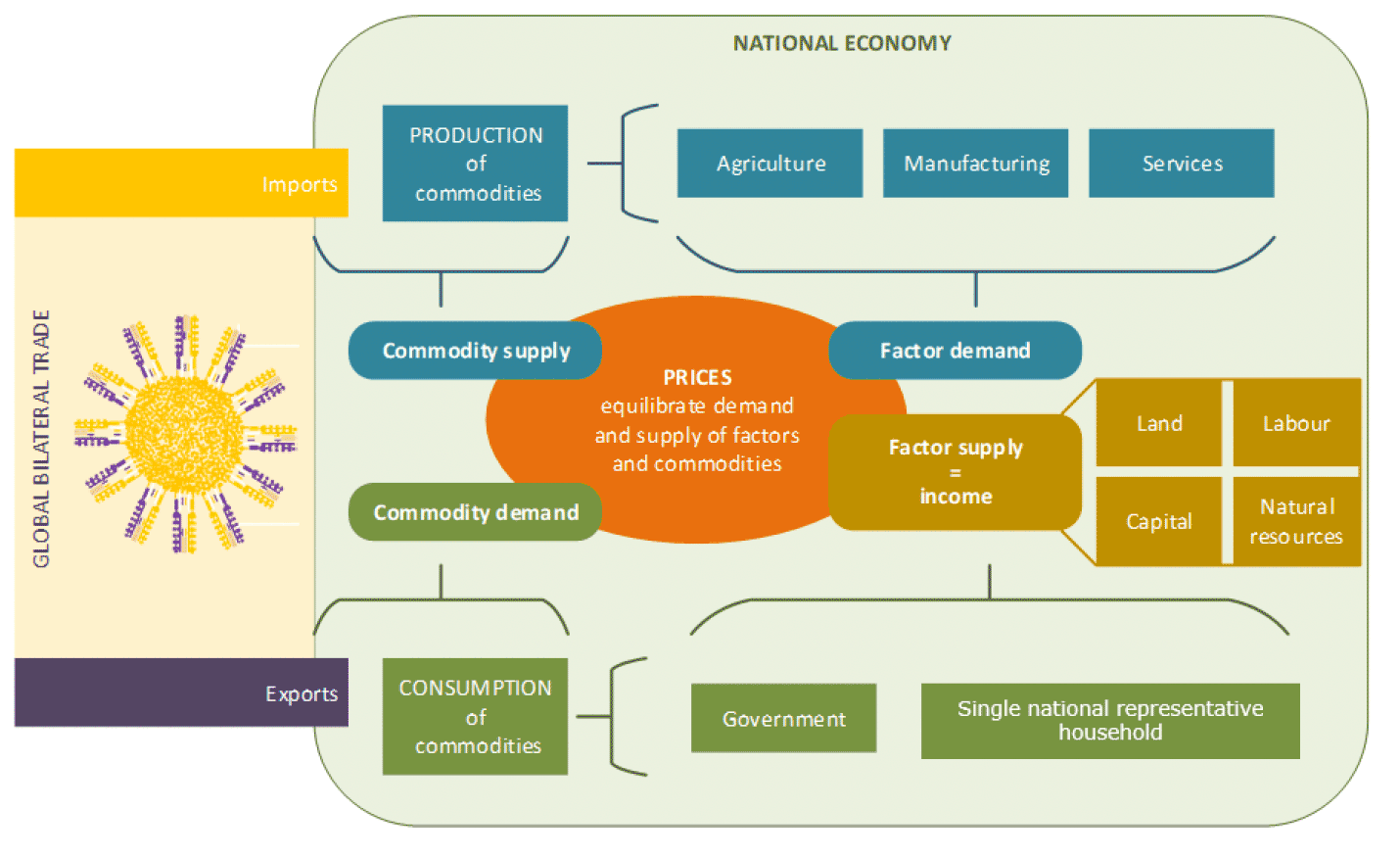Agricultural food and drink sector - impact of future UK Free Trade Agreement scenarios: research
This research assesses the impacts of future Free Trade Agreements (FTAs) between the UK and four selected non-EU trading partners on key Scottish agricultural sectors. The work combines trade-model and farm-level analysis, supplemented by industry interviews and desk-based research.
2. Methodology
2.1 General
Figure 2‑1 summarises the overall methodological approach. It consists of a combination of desk-based and primary research followed by economic modelling using a combination of the MAGNET Computable General Equilibrium (CGE) model and MS-Excel based analysis. Section 2.2 outlines the methodological steps in further detail with supplementary information contained in Annex I.

Source: Andersons and Wageningen University and Research (WUR)
2.2 Methodological Steps
1 Inception Meeting: Andersons, WUR and the Project Steering Group clarified, at the outset, the project's priorities, timelines, datasets and other resources which could help the study.
2 Desk-Based Study: this stage consisted of two strands;
a) Data Gathering: upon project commencement, numerous data sources were identified. Some were under the auspices of RESAS and the Scottish Government. Several other data sources were also used to fulfil the project's objectives. These sources included;
- UK-based sources: in addition to the Scottish Government, particularly RESAS, data from various other UK-based governmental organisations such as Defra, Department for International Trade, and the HMRC were deployed during this study. Additional data was also obtained from Levy Boards, trade associations, the National Farmers' Union Scotland (NFUS), and others.
- Sources in selected non-EU countries: data from overseas governmental organisations encompassing The Government of Canada (Canadian Government), the New Zealand Government, the Australian Government, the Saudi Arabian Government, and the UAE Government were also consulted. Data from trade associations representing businesses in these countries was also consulted.
- Other overseas sources: such as the EU Commission, EUROSTAT, WTO, OECD, UN FAO, UN Comtrade, and the USDA.
In addition, further data sources associated with the MAGNET model framework (see Step 5) were utilised. Additional data sources managed by Andersons were also made available, such as;
- Andersons' NTMs Model: uses 25-30 cost sub-categories to assess NTMs' costs on UK agri-food trade. Andersons NTMs model was originally developed based on UK-EU trade as well as generic third country trade entering the UK. The model was updated for this study and expanded to include the countries/blocs within scope. It assesses NTMs costs on both a "checked load" (subject to the full range of regulatory checks) and on a probabilistic basis (i.e. averaged over 100 loads to account for checking rates etc.).

Source: The Andersons Centre
Note: NTMs costs in this study are primarily expressed in AVE terms.
- ABC Books: 90th edition data was used to assess the farm-level impacts of new FTAs on the potatoes sector (Chapter 7).
b) Evidence Review: was undertaken in the early stages of the study. It identified and examined what overlapping or supporting work was undertaken in recent years, thus preventing a repetition of effort and resources. It looks at the impact of FTAs on UK and Scottish agriculture as well as the impact of other trade deals of relevance to this study. It also examines key issues such as tariffs, tariff rate quotas (TRQs), non-tariff measures (NTMs) and labour. Given that most of the previous studies have been undertaken at a UK-level, this was also the main focus of the Evidence Review. However, where possible, Scottish-level effects, particularly at the farm level were also assessed. Chapter 3 summarises the key findings. Annex II contains the full Evidence Review. It serves as a useful backdrop and grounding for most of the chapters in the report.
The inputs from both the Data Gathering and Evidence Review stages were used to establish the baseline situation for UK and Scottish agriculture in terms of output and sales by geographic market. It uses 2018-20 as the base period (Base). This is because at the time of compiling this part of the study (December 2021 to February 2022), it was the latest period for which full-year data were available. Whilst the Covid-19 pandemic did skew the results somewhat for 2020, these effects were minimised by averaging over a three-year period. Also, as the Covid Crisis is anticipated to lead to some long-term changes in supply-chains (e.g. increased online ordering), it is important that these effects are also reflected.
3 Interim Report Update: was submitted upon completion of the Evidence Review. It set-out the key initial findings and how remaining knowledge gaps would be addressed.
4 Primary Research: collected evidence from industry experts to ascertain the specific impacts of each FTA on the Scottish agricultural sectors selected for examination. This helped to provide a greater Scottish context to the economic modelling. In total, 19 in-depth discussions (circa 30-45 minutes' duration) took place with a variety of stakeholders as summarised in
5 Table 2‑1. Additional shorter discussions on specific points were also held with several industry participants. Some participants also provided supplementary information which helped to further expand the data gathered over the course of the study.
| Sector | No. of Interviews | Stakeholder Type |
|---|---|---|
| Beef and sheep | 5 | Includes 2 processors & 3 trade bodies / farming associations |
| Dairy | 3 | 2 processors, 1 trade body |
| Cereals | 3 | 1 trade body, 2 traders/suppliers |
| Potatoes | 2 | 1 grower/supplier and 1 specialist industry expert |
| Overseas input | 4 | 3 trade bodies and 1 governmental organisation |
| Other / general | 2 | 2 international trade experts |
| Total | 19 |
Source: The Andersons Centre
Notes: Some discussions, particularly with overseas experts, spanned multiple sectors. In addition, some discussions also had multiple participants.
6 Economic Modelling: combined global CGE modelling (using MAGNET) and MS Excel-based analyses to quantify the impact of Brexit and the FTAs within scope at a UK sectoral level (i.e. effects on Gross Value Added (GVA), impacts on supply, demand, prices and trade). Subsequently, additional Excel analysis was run on a Scottish farm-level to ascertain the potential impacts of the FTAs on Scottish agri-food and farming (see Chapter 8). Below is a top-level overview of the sub-steps used with additional detail provided in Annex I.
- The MAGNET model: is based on neo-classical microeconomic theory and builds upon the widely used Global Trade Analysis Project (GTAP) database. As a CGE model, it has economy-wide coverage and is a dynamic, multi-regional, multi-commodity CGE model, covering the entire global economy. This includes 18 agri-food commodities and 9 food processing sectors as well as a wide selection of non-agricultural commodities.
As a global model it covers all regions of the world. For this project, individual MAGNET regions were aggregated into 14 blocks, but the focus countries – the UK, Australia, New Zealand, Canada, GCC countries were kept disaggregated.
Being neo-classical, prices adjust to balance supply and demand in all markets for commodities and factors of production (like land and labour), while still allowing the imposition of production or trade quotas in addition to price-based policies (taxes, subsidies, etc.). Figure 2‑3 depicts the circular flow of commodities and key factors underpinning the MAGNET CGE model. Market adjustments in MAGNET are driven by the following factors;
i. the policies in place
ii. commodity supply resulting from price-taking and cost-minimizing producers (one producer per sector)
iii. commodity demand from a utility maximising household (one per country/region);
iv. feedback link between demand for factors by producers which affects their price and thus available income of the household
v. adjustments in all bilateral international commodity trade (products are differentiated by origin)

MAGNET has an extensive scientific track record among which foresight and policy studies in;
- food security (Doelman et al. 2019[1]; van Meijl et al. 2020[2]; Brinkman et al. 2020[3])
- food system interventions (Kuiper and Cui 2020; Latka et al. 2021),
- SDGs achievement under different development pathways (Philippidis et al. 2020[4]), and
- Contributions to large multi-model integrated sustainability assessments (Leclère et al. 2020[5]; Stehfest et al. 2019[6]; Frank et al. 2019[7]; Fujimori et al. 2019[8]).
Through commissioned studies MAGNET serves as a decision support tool for the European Union and national governments. It has been used by the European Commission, OECD, IFAD and others. Recently MAGNET has been applied in a study for the European Parliament to assess the impact of Brexit in Fisheries (Bartelings and Smeets Kristkova, 2022[9]).
The key datasets underpinning the MAGNET modelling for this study are;
- GTAP dataset: the GTAP dataset forms the core of the GTAP-MAGNET database. It is a fully documented, publicly available global database containing complete bilateral trade information, transport and protection linkages (all represented in dollar values). The current V10 GTAP dataset represents the world economy in 2014 and is utilised by thousands worldwide as a key input into most CGE analyses of global economic issues. An overview is documented in the Journal of Global Economic Analysis in November 2019.[10] This study used version 10.1 of the dataset; an interim release available to GTAP advisory board members where the representation of agricultural production is better aligned with the FAO production data than the public version. For computational reasons, all GTAP-based CGES, including MAGNET, use an aggregation of the GTAP database with a limited number of regions and sectors.
- Additional key data sources: MAGNET's ability for analysing agri-food trade is enhanced by splitting several standard GTAP sectors into MAGNET-specific sectors. These splits rely mostly on the regularly updated global database on agricultural production from the FAO, which contain the production and price data needed to compute production in Dollar values compatible with the GTAP database. Details on trade (value flows and protection levels in ad-valorem equivalents), aside from the products within the scope of this study, are obtained from BACI[11] and TASTE,[12] which provide the bilateral harmonized and balanced data needed for a CGE model database.
There are two important sectoral classifications (or splits) for this project which are worth noting. Firstly, is the split of the GTAP sector called "Bovine cattle, sheep and goats, horses". This has been split by separating "Bovine cattle" and "other ruminant livestock" which are mainly sheep in the case of Scotland/UK. In addition, MAGNET does not model barley specifically, but instead it is subsumed within the "other grain" sector. For the UK, other grain chiefly relates to barley and, therefore, it was decided to use this category as a proxy for barley in the modelling.
- CGE modelling calibration for scenario-based analysis: considering the scenarios outlined in Chapter 1 and how the MAGNET model is structured, calibrations were required in the CGE modelling to facilitate the long-term analysis of each scenario. These calibrations are summarised in Table 2‑2 below. As the latest version of the GTAP dataset runs to 2014, WUR updated the inputs needed for the MAGNET model used in this study to 2019 – the latest year for which the complete data (including both UK and other global inputs) is available.
Table 2‑2: Overview of Baselines and Scenarios used in CGE Modelling
Scenario Name: Main Baseline (Incorporating Brexit) (2014-2037)
Description: Incorporate Trade measures based on historical evidence (2014-2019) and Incorporate Brexit trade and labour shocks (2019-2037)
Scenario Name: Alternative Baseline (No-Brexit) (2014-2037)
Description: Incorporate Trade measures based on historical evidence, but Brexit-related trade and labour shocks are not incorporated.
Scenario Name: FTA Low Liberalisation (Low Lib) (Comparative Static 2037)
Description: 25% decrease of NTMs for the focus countries, zero import tariffs (FTAs assumption)
Scenario Name: FTA High Liberalisation (High Lib) (Comparative Static 2037)
Description: 50% decrease of NTMs for the focus countries, zero import tariffs (FTAs assumption)
Sources: WUR and The Andersons Centre
From there, estimates needed to be compiled for the Main Baseline covering the 2019-2037 period – the timeframe needed to assess the long-term impacts of the full removal of tariffs across all commodities in the selected FTAs. Once this work was completed, a top-level comparison was undertaken between the Main Baseline and No-Brexit scenarios (see section Chapter 6 below). Thereafter, the impact of each selected FTA within a Low and High liberalisation context was compiled and aggregated (see section 7). The results were then compared with the Main Baseline to ascertain the projected percentage changes over the forecast period.
- Quantify impacts on Scottish agri-food and farming: these assessments were compiled based on the MAGNET modelling analysis and are reported on in Chapter 7. To assess the impact on Scottish agri-food, the projected changes to GVA and prices were applied to average annual output in Scotland during 2018 to 2020 to analyse the potential impacts for each selected commodity. The farm-level analysis was undertaken based on the Scottish Farm Business Income dataset for 2019/20. For potatoes, insights from the Scottish Farm Management Handbook[13] and the ABC Book[14] as well as primary research were used to compile an impact analysis. This is because MAGNET does not cover the potatoes' sector in sufficient detail.
7 Research Analysis: was undertaken in conjunction with the Report Development stage, based on the economic modelling results and farm-level assessments. This was accompanied by a commentary on the implications for Scottish agriculture. Here, insights from the Primary Research were also used to ascertain the impact of the Transition Period ending and the FTAs within scope on Scottish agri-food trade. Consideration was also given to the short-term impact (6-12 months) and the long-term impacts (assumed in this study to be when tariff- and quota-free trade is fully in place (i.e. after 15 years)) from application of the policy measures.
8 Report Development & Finalisation: the draft summary report, with accompanying Annexes, were compiled to set-out the study's findings. The draft report was peer-reviewed internally by Andersons colleagues. Feedback was incorporated into the report which was submitted to the Project Steering Group. Thereafter, a presentation and feedback session was completed and agreed refinements were incorporated into the final report.
Contact
Email: frederick.foxton@gov.scot
There is a problem
Thanks for your feedback